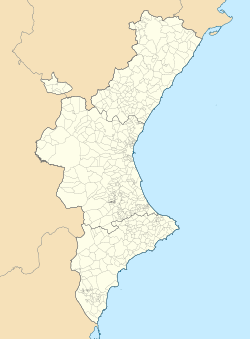Santa Pola facts for kids
Quick facts for kids
Santa Pola
|
|||
|---|---|---|---|

Fortress Castle of Santa Pola
|
|||
|
|||
| Country | |||
| Autonomous community | |||
| Province | Alicante | ||
| Comarca | Baix Vinalopó | ||
| Government | |||
| • Body | Ayuntamiento | ||
| Area | |||
| • Total | 58.6 km2 (22.6 sq mi) | ||
| Elevation | 6 m (20 ft) | ||
| Population
(2022)
|
|||
| • Total | 36 174 | ||
| • Density | 621,96/km2 (161,090/sq mi) | ||
| Demonym(s) | santapolero/ra; icositano/na | ||
Santa Pola is a sunny coastal town in the Valencian Community, Spain. It sits right by the Mediterranean Sea. The town covers an area of about 58.6 square kilometers. Around 36,174 people live here, with 6,000 of them in the nearby area of Gran Alacant.
Santa Pola is famous for its important salt evaporation ponds, called salines. These salt ponds are still in use today. Most of this area is part of the Natural Park of Salines de Santa Pola. This park is a special Ramsar site, which means it's important for wetlands and wildlife.
The town was built on the remains of an old Roman village. This Roman village was called Portus Ilicitanus, meaning "Harbour of Elche". After being empty for many years, a castle was built in the 1500s. This castle helped people move back to Santa Pola. You can learn more about its past at the local archeological museum.
Today, Santa Pola is a busy fishing and tourist town. Its population more than doubles in the summer. Many visitors come from other parts of Spain, like the Alicante province, the Basque autonomous community, and Madrid. People also come from France and the UK. You can even take a boat trip from Santa Pola to the nearby island of Tabarca.
The newer area of Gran Alacant is about 5 kilometers north of Santa Pola. It's home to about one-third of the district's population. Next to Gran Alacant is the Carabasi area, which is a nature reserve. Gran Alacant is also very close to Alicante Airport.
In 2009, the Valencian Government announced plans to extend the Alicante Tram system. This new tram line will go south through Alicante Airport and El Altet. It will have stations in Gran Alacant and Santa Pola. The line will then continue to Guardamar and Torrevieja, ending in Murcia.
Contents
What Does the Name Santa Pola Mean?
The name Santa Pola comes from Saint Paula. This name is linked to Saint Paul the apostle. Tradition says he arrived at Tabarca island. However, the name might also come from the Latin word "palus." This word means "marsh" or "swamp," which fits the area's salt marshes.
Santa Pola's Long History
People have lived in the Santa Pola area for a very long time. The first settlements date back to about 3000 BC. Tools and cave paintings from the Stone Age have been found in the Cueva de las Arañas del Carabassí. Remains of ancient hunter-gatherers were also found in the Cueva de las Teresitas.
Ancient Settlements and Roman Port
Around 400 BC, a small walled village was built near the Vinalopó river. This village was an important trading spot for Greeks and Iberians. Later, in the 1st century AD, a port was built nearby. It was called Portus Illicitanus, serving the city of Illici.
This port was very important for trade by sea in the region. It worked together with the port of Cartagena. In 460 AD, a Roman emperor's fleet was burned at this port.
Discovering Roman Remains
You can still see parts of the Roman settlement today. There is a burial ground, a factory where fish was salted, and the Roman House of Palmeral. People first wrote about these remains in 1621. However, they were properly dug up and studied in the 20th century.
How Santa Pola Makes Money
Santa Pola's economy relies on three main activities. These are farming, making crafts, and fishing. In 2003, only a small part of the population, about 1.3%, worked in farming. Farming here needs special watering systems.
Farming in Santa Pola
Farmers grow crops on about 200 hectares of land. This includes 102 hectares of orange trees, 74 hectares of mandarin trees, and 18 hectares of pomegranate trees. They also use 230 hectares for vegetables. These vegetables include melons, shallots, and broccoli.
Languages Spoken in Santa Pola
Santa Pola has two official languages: Valencian and Spanish. Valencian is a language spoken in the Valencian Community. Spanish is the official language of Spain.
Recent information shows that about 90% of the people in Santa Pola speak Valencian. More and more different languages are being heard in the area. This is partly because many new people have moved to the region. For example, in areas like Gran Alacant, many people speak English.
Gallery
See also
 In Spanish: Santa Pola para niños
In Spanish: Santa Pola para niños










